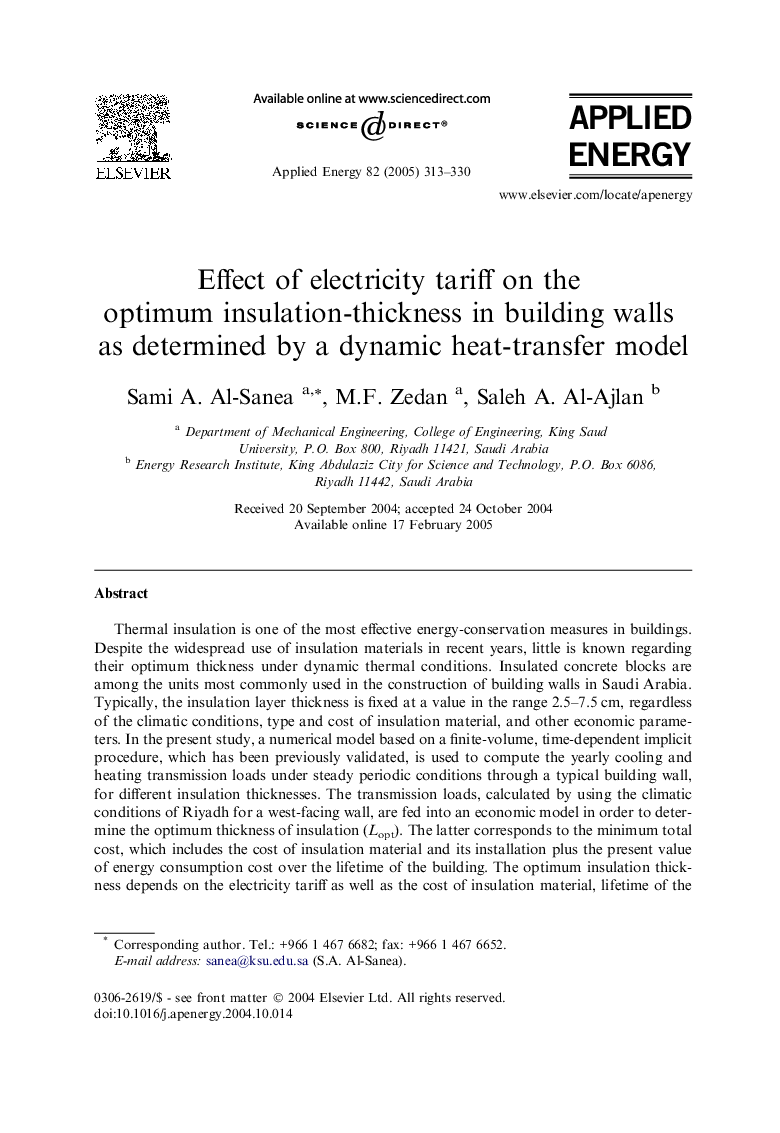| کد مقاله | کد نشریه | سال انتشار | مقاله انگلیسی | نسخه تمام متن |
|---|---|---|---|---|
| 10282115 | 502011 | 2005 | 18 صفحه PDF | دانلود رایگان |
عنوان انگلیسی مقاله ISI
Effect of electricity tariff on the optimum insulation-thickness in building walls as determined by a dynamic heat-transfer model
دانلود مقاله + سفارش ترجمه
دانلود مقاله ISI انگلیسی
رایگان برای ایرانیان
کلمات کلیدی
موضوعات مرتبط
مهندسی و علوم پایه
مهندسی انرژی
مهندسی انرژی و فناوری های برق
پیش نمایش صفحه اول مقاله

چکیده انگلیسی
Thermal insulation is one of the most effective energy-conservation measures in buildings. Despite the widespread use of insulation materials in recent years, little is known regarding their optimum thickness under dynamic thermal conditions. Insulated concrete blocks are among the units most commonly used in the construction of building walls in Saudi Arabia. Typically, the insulation layer thickness is fixed at a value in the range 2.5-7.5Â cm, regardless of the climatic conditions, type and cost of insulation material, and other economic parameters. In the present study, a numerical model based on a finite-volume, time-dependent implicit procedure, which has been previously validated, is used to compute the yearly cooling and heating transmission loads under steady periodic conditions through a typical building wall, for different insulation thicknesses. The transmission loads, calculated by using the climatic conditions of Riyadh for a west-facing wall, are fed into an economic model in order to determine the optimum thickness of insulation (Lopt). The latter corresponds to the minimum total cost, which includes the cost of insulation material and its installation plus the present value of energy consumption cost over the lifetime of the building. The optimum insulation thickness depends on the electricity tariff as well as the cost of insulation material, lifetime of the building, inflation and discount rates, and coefficient of performance of the air-conditioning equipment. In the present study, the effect of electricity tariff on the computed optimum insulation thickness is investigated. Different average electricity tariffs are considered; namely, 0.05, 0.1, 0.2, 0.3 and 0.4 SR/kWh (designated as Cases 1-5, respectively; 1 US$Â =Â 3.75 Saudi Riyals). Results using moulded polystyrene as an insulating material show that the values of Lopt are: 4.8, 7.2, 10.9, 13.7 and 16.0Â cm for Cases 1-5. Under the conditions of optimal insulation thickness for each electricity tariff, Case 1 gives the lowest total cost of 17.4 SR/m2, while Case 5 gives the highest total cost of 53.1 SR/m2. Corresponding thermal performance characteristics in terms of yearly total and peak transmission loads, R-value, time lag and decrement factor are presented.
ناشر
Database: Elsevier - ScienceDirect (ساینس دایرکت)
Journal: Applied Energy - Volume 82, Issue 4, December 2005, Pages 313-330
Journal: Applied Energy - Volume 82, Issue 4, December 2005, Pages 313-330
نویسندگان
Sami A. Al-Sanea, M.F. Zedan, Saleh A. Al-Ajlan,